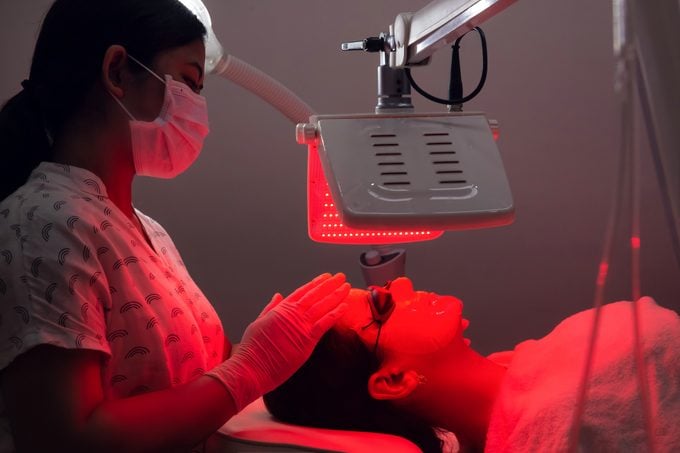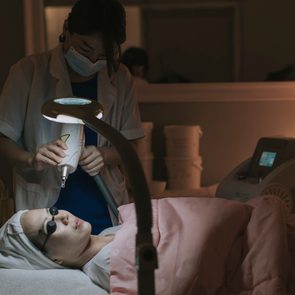What Is Red Light Therapy? The Benefits and Risks
Updated: Jun. 01, 2021
Could red light therapy be the secret to smooth skin and a thick head of hair?
The power of light therapy
We all know that great feeling of sunlight on your face, but you may not realize that light can be surprisingly powerful medicine. And each color of light can be used to treat different skin and health conditions.
Red light is in what’s known as the visible light spectrum—that is, light that you can see. Visible light has wavelengths of about 400 to 780 nanometers (nm), says Roger Ceilley, MD, a fellow of the American Academy of Dermatology who practices at Dermatology P.C. in West Des Moines, Iowa. Red light has the longest wavelength, falling at around 700 nm.
To harness these wavelengths during therapy, devices “apply” red light in a non-invasive treatment that has anti-aging benefits, and helps with acne, pain management, even hair loss. Along with red light therapy, you might also hear it referred to as photobiomodulation, low-level laser or light therapy, soft laser therapy, or phototherapy.
Red light therapy for wrinkles
Red light-emitting diodes (LED) is a common treatment for facial wrinkles that can even be used at home. “Red light is used as an anti-inflammatory, boosts blood flow, and stimulates collagen production,” says Purvisha Patel, MD, board-certified dermatologist and founder of Visha Skincare in Germantown, Tennessee.
Red light, in particular, is primarily used for anti-aging complexion concerns.
“The longer the wavelength of light, the deeper it penetrates into skin,” says Dr. Ceilley. “Theoretically, this can stimulate some collagen development.” Greater collagen production helps smooth out wrinkles and lines and helps maintain skin elasticity. Studies are underway to discover what colors of light are actually best for fighting wrinkles, according to research in BMJ Open. Is it really red light or is amber light more effective?
Do at-home anti-aging red LED devices work for wrinkles?
At-home red LED devices that target the skin for anti-aging are exciting because they allow you to try an in-office procedure at home. But how well do the at-home devices actually work? “We don’t know how effective these are, and they’re not regulated very well,” says Dr. Patel.
“Unfortunately, these devices are being used, but there aren’t a lot of good studies to say how well they work. When these are FDA-approved, they are approved for safety—not efficacy,” adds Dr. Ceilley, who says more long-term studies are needed to truly evaluate their role in anti-aging.

Red light therapy for acne
Blue light LED therapy is best known for battling acne breakouts. It’s the blue light—which has a shorter wavelength than red—that acts as an antibacterial that annihilates the c. acnes (Cutibacterium acnes) bacteria that leads to pimples.
However, red light plays a key role, too. It affects the release of certain proteins, which ultimately decreases the inflammatory response. A combination of blue and red LED light, therefore, has been shown to provide a one-two punch on both bacteria and inflammation involved in acne formation.
After three months of use, blue-red light therapy significantly reduced the number of acne lesions in people with mild to moderate acne, per a study published in 2017 in the Journal of the American Academy of Dermatology. The control group, which used topical benzoyl peroxide, also reported positive results. But blue-red light therapy could be an option for acne patients who find topicals irritating to their skin.
Red light therapy for pain
Color and light therapy can also go by the name of “colorpuncture,” a complementary medical treatment that is similar to acupuncture. Instead of using a needle, though, light is applied to specific points in the body. Each color can be used for a purpose. Red light is generally stimulating and may boost circulation in the body, according to a study published in 2018 in Alternative and Complementary Therapies.
“The theory is that light can affect the cellular structure of the body,” says study author Janet Lynn Roseman-Halsband, PhD, an associate professor in integrative medicine at Nova Southeastern University in Fort Lauderdale, Florida. “In a broad sense, red can be used for pain. But this depends on the person and the specific condition they’re suffering from.” It’s not designed as a stand-alone therapy and clinical research needs to be done to verify the treatment and methods.
Red light therapy for hair loss
One of the emerging ways red light therapy is being used is in hair growth devices, says Dr. Patel. Low-level laser therapy (LLLT) that emits red light is also used to promote hair growth, which can be administered through a cap or helmet you wear on your head. The belief is that the specific wavelength of light brings blood flow and nutrients to your scalp to stimulate the hair follicle, leading to hair growth.
A review of 10 randomized controlled trials, most of which compared LLLT to sham treatment (and some that used red light specifically), concluded that these devices were both safe and effective in treating hair loss in both men and women. Published in Skin Appendage Disorders in 2020, trials lasted at least 16 weeks and showed that these devices increased the number of hairs, hair growth, and scalp coverage. Mild side effects included itchiness and scalp tenderness.
However, if you are losing hair, see your doctor. Dr. Patel reports an increasing number of people losing their hair in response to the stress of the pandemic. But there could also be an underlying health problem. “Don’t buy a hair helmet in the false hope that things will get back to normal [in terms of your hair loss],” she says. “There may be a medical condition that needs to be treated, instead.”
Possible side effects and warnings of red light therapy
If you’re choosing to use a red LED device at home to treat skin concerns like acne or wrinkles, purchase an FDA-approved device. These have been cleared for safety. Other at-home devices that don’t have this designation are risky since it’s not clear if the type or intensity of the light used will be safe for skin. Another caveat: Avoid looking directly at the lights. And if you have a history of eye conditions or you take medications that increase photosensitivity, ask your doctor if it’s safe for you to use one.


















